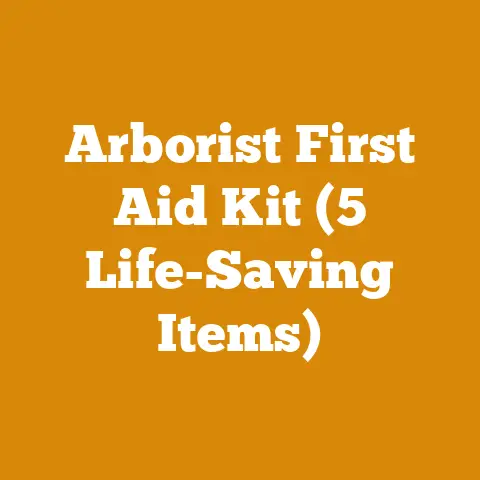West Coast Saw (5 Tools Every Logger Needs)
Ever been out in the woods, ready to tackle a big job, and realize you’re missing just that one tool that could make all the difference?
I’ve been there.
It’s frustrating, isn’t it?
Whether it’s cutting through a massive log or trimming branches swiftly, having the right tools is crucial.
As someone who’s spent countless hours among towering trees and buzzing chainsaws, I’ve learned that having the right gear can make or break your day.
So, let’s chat about five essential tools from West Coast Saw that every logger needs.
Tool #1: Chainsaw Chain Sharpener
Why It Matters
A dull chain is like a butter knife on steak—useless.
Keeping your chainsaw chain sharp is essential for efficiency and safety.
But let’s not stop there; let’s explore why sharpening matters on a deeper level.
Sharper Means Safer
A sharp chain reduces the risk of kickbacks, which are sudden jolts that can occur when the chain gets stuck in the wood.
These can be dangerous and lead to injuries.
I’ve seen it happen, and it’s something you want to avoid at all costs.
Efficiency is Key
When your chain is sharp, you use less fuel and exert less effort.
I recall working on a massive oak tree; a sharp chain meant fewer breaks and faster progress.
My Experience
I remember a time when I tried to push through with a dull chain.
Not only was it exhausting, but it also increased the risk of kickbacks.
It was a turning point for me—never again would I underestimate the power of a sharp chain.
Steps to Use a Chain Sharpener
- Assess the Chain Check for dullness or damage.
A sharp chain should cut smoothly without forcing the saw.
Look for shiny spots on the cutters; that’s a sign they need sharpening. - Secure the Saw Place the chainsaw in a vise or on a stable surface to prevent movement while sharpening.
This stability is crucial for maintaining consistent angles on each cutter. - Use the Sharpener Follow the angle marked on the chain’s teeth.
Consistency is key for smooth cutting.
Use smooth, even strokes and count them to ensure each cutter is equally sharpened. - Check Your Work After sharpening a few teeth, test by cutting a small piece of wood.
If it feels like butter, you’re good to go!
Safety Reminder
Always wear gloves and eye protection when sharpening your chain to avoid injuries from metal shavings or slips.
Safety glasses protect your eyes from flying debris, and gloves keep your hands steady.
Tool #2: Felling Wedges
Why You Need Them
Felling wedges prevent your chainsaw from getting pinched in the tree and guide the direction of the fall.
Let’s delve into why these wedges are invaluable.
Control the Fall
Felling wedges give you control over where a tree will fall.
This control can prevent damage to property or injury to people and animals nearby.
Prevent Pinching
When cutting large trees, the weight can close in on your saw, pinching it.
Wedges keep the cut open, allowing for smoother operation.
Story Time
Once, during a windy day, I underestimated how much a wedge could help.
The tree twisted unpredictably, and I learned my lesson—never skip wedges!
They are your silent partners in directing the fall.
Using Felling Wedges Safely
- Plan Your Cut Identify the fall direction and clear an escape path.
Ensure there’s nothing valuable or dangerous in the fall zone. - Start the Notch Cut Cut a notch on the side where you want the tree to fall.
Aim for about 70 degrees and about one-fifth of the diameter into the tree. - Insert Wedges After making the back cut, insert wedges to keep the cut open.
Gently tap them in until they’re snug but not forcing anything yet. - Finish the Cut Continue cutting until the tree begins to fall, using wedges to control the direction.
If needed, tap the wedges further to guide it accurately.
Important!
Stay aware of your surroundings and have an escape route planned at all times.
Trees can be unpredictable; always err on the side of caution.
Tool #3: Log Peavey
What It Does
A log peavey is perfect for rolling, lifting, and positioning logs safely.
It’s like having an extra pair of strong arms with you in the forest.
Versatility in Action
Whether you’re moving logs off trails or stacking them for transport, a peavey gives you leverage and control beyond what any manual effort could provide.
Personal Insight
On rough terrain, moving logs without a peavey can be back-breaking work.
This tool saves time and my back.
Once, while clearing a path after a storm, my peavey was indispensable in shifting large logs out of harm’s way.
How to Use a Log Peavey
- Position the Peavey Place the hook around the log you’re moving.
Ensure it’s secure before applying pressure. - Leverage and Roll Use the handle as leverage.
Roll or pivot logs into place carefully.
Use your body weight to assist in moving heavier logs. - Maintain Balance Keep control by maintaining firm footing and balance.
Always be aware of your surroundings to avoid slips or falls.
Safety Tips
Watch for slippery surfaces and ensure your grip is secure before applying force.
Proper footwear with good traction can make all the difference here.
Tool #4: Chainsaw Protective Gear
Why It’s Critical
Safety gear isn’t optional—it’s essential.
From helmets to boots, each piece plays a role in keeping you safe.
Let’s take a closer look at each component’s role in safety.
Preventing Injuries
Chainsaws are powerful tools designed for efficiency but can cause severe injuries if mishandled or if safety gear is neglected.
Peace of Mind
Knowing you’re protected allows you to focus more on your work and less on potential accidents.
Essential Protective Gear Checklist
- Helmet with Face Shield: Protects from falling debris and flying wood chips.
- Hearing Protection: Chainsaws are loud; protect your hearing with proper earmuffs.
- Kevlar Chaps or Pants: Stops chainsaws instantly upon contact.
- Steel-Toe Boots: Shields feet from falling logs or accidental drops.
- Cut-Resistant Gloves: Offers better grip and protects hands from cuts and scratches.
Personal Safety Tips
- Fit and Comfort Ensure all gear fits well; uncomfortable gear can distract you from your work.
Try on different sizes if needed. - Regular Checks Inspect gear regularly for wear and damage.
Look for tears or worn-out seams that might compromise protection. - Layer Up in Cold Weather Dress in layers but ensure you can move freely.
Overheating can be as dangerous as being too cold.
Tool #5: Forestry Axe
Purpose and Use
A forestry axe is ideal for limbing trees and splitting small logs when precision is needed beyond a chainsaw’s capability.
Precision Work
Chainsaws are great for bulk, but when you need finesse, an axe provides that precision cut.
A Quick Anecdote
There was this one time when my chainsaw ran out of fuel mid-job.
My trusty forestry axe helped me finish up without delay—I was able to continue working efficiently because I had both tools at my disposal.
Using a Forestry Axe Safely
- Inspect Before Use Check for cracks or loose heads on the axe.
A secure head ensures safe operation. - Proper Grip and Stance Stand with feet shoulder-width apart and use both hands on the axe handle for control.
Proper stance prevents overextending during swings. - Controlled Swings Use controlled swings, letting gravity do most of the work.
This reduces fatigue and increases accuracy. - Clear Work Area Ensure no one is within reach of your swing radius.
Always be aware of people and obstacles around you to avoid accidents.
FAQs: Common Concerns
How often should I sharpen my chainsaw chain?
It depends on usage, but generally after every few hours of cutting or if you notice it’s not cutting as efficiently as before.
Can I use any wedge for any tree?
Choose wedges based on tree size; larger trees require more substantial wedges for effective control.
What’s better, peavey or cant hook?
Both are useful; peaveys are better for rough terrain due to their pointed ends, while cant hooks are ideal for flat surfaces thanks to their flat bases.
Do I need all this protective gear?
Yes, every piece is designed to protect against specific hazards associated with logging activities.
What’s the best way to store these tools?
Keep them clean, dry, and in a secure location to prevent damage or theft.
Regular maintenance checks ensure longevity and reliability when needed most.
Remember, preparation is key in this line of work.
Having these tools not only makes your job easier but ensures you return home safely at the end of each day.
What’s in your logging toolkit?
And how have these tools made your life easier?






